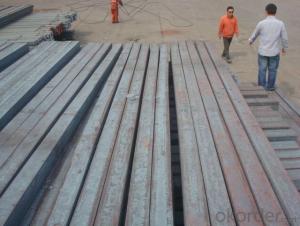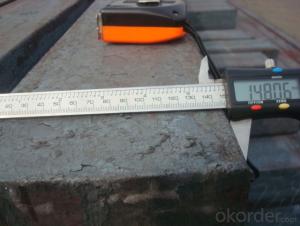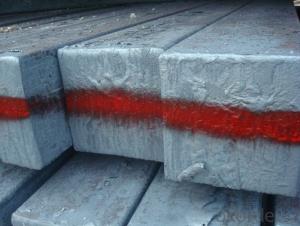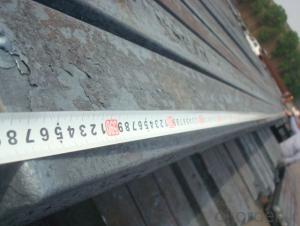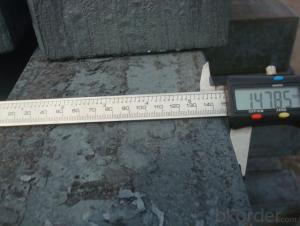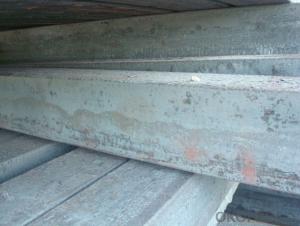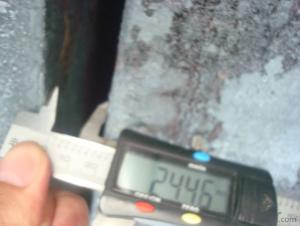Steel Billet/Bloom Manufactured by Continue Casting Blast Furnace
- Loading Port:
- Tianjin
- Payment Terms:
- TT OR LC
- Min Order Qty:
- 1000 m.t.
- Supply Capability:
- 10000 m.t./month
OKorder Service Pledge
OKorder Financial Service
You Might Also Like
Steel Billet/Bloom Manufactured by Continue Casting Blast Furnace
1.Structure of Steel Billet/Bloom Manufactured by Continue Casting Blast Furnace
Continue Casting Steel Billet Manufactured By Blasting Furnace is the raw material of all kinds of steel mill. Billet section of square, round, flat, rectangular and abnormity, etc Several, mainly related to shape of rolled products. Simple rolled section steel, choose cross section of square billet or rectangular billet. rolling The sector products such as flat steel, Angle steel, select the rectangular billet or slab. Had better profiled billet when production beams, channels, and in rolling process Lines and improve the yield. The raw material of round billet is the production of seamless tube.
2.Main Features of Steel Billet/Bloom Manufactured by Continue Casting Blast Furnace.
Continue Casting Steel Billet Manufactured By Blasting Furnace section size should meet the requirements of rolling deformation and finished product quality, but also roll strength and biting condition of restrictions. General steel Billet section height H. And the roll diameter D The ratio of the ( namely H/D) Should be less than or equal to zero 0.5 . Length of steel billet by finishing temperature, Rolling time and the length of the product Or times ruler. When heated too long accident prone to bump the furnace wall of steel, too short, furnace bottom utilization rate is not high, influence the heating furnace production. For the production Choose a variety of steel and steel billet, should consider the affinities of billet, as far as possible in order to improve the productivity of the roughing mill, simplify the stock management of workshop.
There are three shapes of the steel billets: square billet, slab, rectangular billet The Chinese billet, rectangular billet is mainly suitable for rolling hot rolled strip, building reinforced bar, Ordinary wire, high speed wire rod and various small profile. Of the slab are mainly used for rolling plate and hot coil sheet.
3. Steel Billet/Bloom Manufactured by Continue Casting Blast Furnace Images
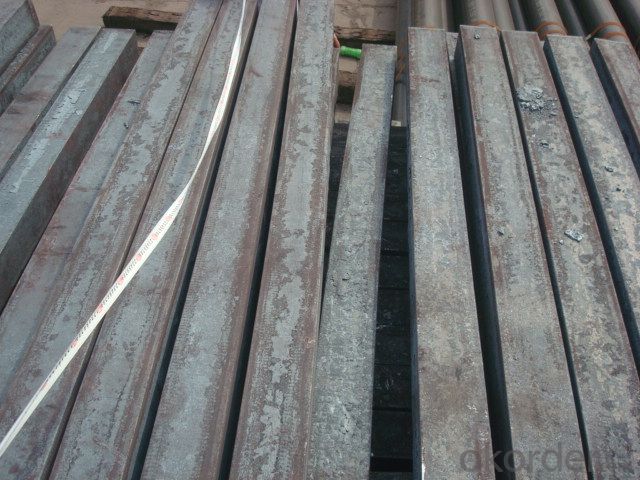

4. Steel Billet/Bloom Manufactured by Continue Casting Blast Furnace Specification
Continue Casting Steel Billet Manufactured By Blasting Furnace rolled steel, after processing can be used for mechanical parts, forging parts, processing all kinds of steel, steel Q345B channel steel, wire rod is the role of the billet. Steel billet is used in the production of semi-finished products, generally cannot be used directly for the society. Steel billets and steel are strictly divided into standard, cannot decide to whether the business enterprise of the final product, and according to unified standards to perform the whole society. Typically, billet and the steel is relatively easy to distinguish, but for some steel billet, and have the same specification and same steel purposes (such as rolling tube billet), whether can be used for other industries, whether through steel processing process, whether through a finished product rolling mill processing to distinguish
Material standard The editor Range of thickness: 150-240 - mm + / - 5 mm width range: 880-1530 - mm + / - 20 mm Length: 3700-10000 - mm + / - 500 - mm Cross-sectional size: 64 * 64; 82 * 82; 98 * 98; 124 * 124; 120 * 150; 152 * 164; 152 * 170 mm Length: 9000 mm Section of tolerance: billet: 1.0 + / - 2.0-1.0 + / - 1.0 mm slab: width: + / - 2.0 mm thickness: + / - 3.0 mm The length tolerance: + / - 200 mm Section diagonal tolerance: 3.5-8.0 MM Billet section size protrusions requirements: < 1242 mm, do not allow; > = 1242 mm, < = 2 mm 1242 mm, < = 3 mm Beheading (shear) extension deformation: < 1242 mm billet: no control; The slab: < = 15 mm Surface tilt: no more than billet section 0.1 Bending: every 1 m length is not more than 10 mm The distortion: length < = 5 m, < = 11. ; The length of the < = 7.5 M, < = 5. Material % 3 sp/PS chemical composition: C Mn Si S P
5.FAQ of Steel Billet/Bloom Manufactured by Continue Casting Blast Furnace
We have organized several common questions for our clients,may help you sincerely:
①How about your company?
A world class manufacturer & supplier of castings forging in carbon steel and alloy steel,is one of the large-scale professional investment casting production bases in China,consisting of both casting foundry forging and machining factory. Annually more than 8000 tons Precision casting and forging parts are exported to markets in Europe,America and Japan. OEM casting and forging service available according to customer’s requirements.
②How to guarantee the quality of the products?
We have established the international advanced quality management system,every link from raw material to final product we have strict quality test;We resolutely put an end to unqualified products flowing into the market. At the same time, we will provide necessary follow-up service assurance.
③What is the advantage of the continue Casting steel billet comparing to the die casting steel billet?
Compared with die casting, continuous casting has the advantages of: 1. To simplify the Steel billet The production process 2. Improve the metal yield 3. Improve the quality of the billet 4. Reduces the steel worker's labor intensity 5. Save energy and reduce consumption
- Q: How are steel billets used in the manufacturing of pipeline fittings?
- Steel billets are an essential component in the manufacturing process of pipeline fittings. These fittings are used to connect and control the flow of fluids or gases in pipelines. The first step in using steel billets for pipeline fittings is the selection of high-quality, durable steel. The billets are typically made from low carbon steel, which ensures strength and resistance to corrosion. Once the appropriate steel billets are chosen, they are heated in a furnace to a specific temperature, known as the forging temperature. At this temperature, the steel becomes malleable and can be shaped into various forms. The hot steel billets are then placed into a forging press, where they are subjected to immense pressure. This pressure deforms the steel billets, causing them to take on the desired shape and size. The process is known as forging, and it ensures the strength and integrity of the pipeline fittings. After forging, the steel billets are further processed to achieve the final shape of the pipeline fittings. This may involve machining, welding, or other processes depending on the specific requirements of the fittings. Once the final shape is achieved, the fittings are inspected for quality and undergo various tests to ensure they meet industry standards. These tests include dimensional checks, non-destructive testing, and pressure testing, among others. Once the pipeline fittings pass all the necessary tests, they are ready for installation in pipelines. These fittings play a crucial role in connecting different sections of the pipeline, allowing for the controlled flow of fluids or gases. They provide a secure and leak-free connection, ensuring the safe and efficient operation of the pipeline system. In summary, steel billets are used in the manufacturing of pipeline fittings by undergoing a series of processes including heating, forging, machining, and testing. These fittings play a vital role in connecting and controlling the flow of fluids or gases in pipelines, ensuring the safe and efficient operation of the overall system.
- Q: What are the major steel billet producing countries?
- The major steel billet producing countries are China, India, Russia, Japan, and the United States. China is by far the largest producer of steel billets, accounting for over half of the global production. This is due to the country's massive steel industry, which has experienced significant growth in recent decades. India is the second-largest producer, with a rapidly expanding steel sector as well. Russia is known for its strong steel industry and is the third-largest producer. Japan, although its steel production has declined in recent years, still remains a significant player in the steel billet market. Lastly, the United States is a major producer of steel billets, with a focus on high-quality specialty steel products. These countries play a crucial role in meeting the global demand for steel billets, which are essential raw materials for various industries, including construction, automotive, and infrastructure.
- Q: How are steel billets used in the manufacturing of kitchen appliances?
- Steel billets are an essential component in the manufacturing of kitchen appliances due to their versatile properties and ability to be molded into various shapes and sizes. These billets, which are typically made from low carbon steel, serve as the raw material for the production of kitchen appliances such as stoves, ovens, refrigerators, and dishwashers. The manufacturing process begins with the steel billets being heated to a high temperature, known as annealing, to improve their formability and ductility. Once the desired temperature is reached, the billets are then passed through a series of rolling mills to reduce their size and shape them into the required form. This process, called hot rolling, results in the formation of sheets or plates of steel that can be further processed. These steel sheets or plates are then cut, bent, and formed into the different components of kitchen appliances. For example, the body of a refrigerator or oven is often made from steel sheets that are shaped and welded together to create a sturdy and durable structure. Similarly, the burners and grates of a stove are typically made from steel billets that are cast and machined to the desired shape. The use of steel billets in the manufacturing of kitchen appliances offers numerous advantages. Steel is known for its strength, durability, and resistance to corrosion, making it an ideal choice for kitchen appliances that are subjected to frequent use and exposure to moisture. Furthermore, steel can be easily cleaned and maintained, ensuring the longevity and hygiene of the appliances. In addition to its physical properties, steel is also a cost-effective material for kitchen appliance manufacturing. Its abundant availability and relatively low production costs contribute to making kitchen appliances more affordable for consumers. Overall, steel billets play a crucial role in the manufacturing of kitchen appliances by providing a versatile and cost-effective material that can be shaped, formed, and assembled into various components. Their strength, durability, and resistance to corrosion make steel billets an ideal choice for producing high-quality kitchen appliances that meet the demands of modern households.
- Q: How are steel billets used in the manufacturing of packaging equipment?
- Packaging equipment relies heavily on steel billets as a vital element in its manufacturing process. These billets serve as the primary material for producing diverse parts and components crucial to the functioning of packaging machinery. To begin with, steel billets are typically employed in the fabrication of packaging equipment frames and structures. The robust nature and enduring quality of steel make it an ideal selection for constructing a sturdy framework that provides support to the entire machine. This guarantees that the packaging equipment can endure the demands of continuous operation and heavy loads. Furthermore, steel billets are also instrumental in the production of significant components such as gears, shafts, and rollers. These components play a pivotal role in ensuring the smooth operation and rotation required for efficient product packaging. Steel's exceptional mechanical properties, including high tensile strength and resistance to wear and tear, render it suitable for these critical parts. Additionally, steel billets are frequently utilized in the manufacturing of cutting and forming tools employed in packaging equipment. These tools are responsible for shaping and cutting various materials like cardboard or plastic to create packaging containers or wrap products. The hardness of steel and its ability to maintain sharp edges make it an ideal material for crafting these tools, thus ensuring precise and efficient packaging operations. In conclusion, the significance of steel billets in the manufacturing of packaging equipment cannot be overstated, as they are instrumental in creating the frames, components, and tools necessary for the efficient and reliable operation of packaging machinery. The strength, durability, and versatility of steel billets make them the preferred choice in the packaging industry.
- Q: How are steel billets used in the manufacturing of fasteners?
- Steel billets are an essential component in the manufacturing of fasteners. Fasteners are devices used to join or secure two or more objects together. They are commonly found in various industries such as automotive, construction, and manufacturing. In the production of fasteners, steel billets serve as the raw material. A steel billet is a semi-finished product that typically has a square or rectangle cross-section. It is created through a process called casting, where molten steel is poured into a mold and allowed to cool and solidify. Once the steel billets are obtained, they undergo a series of manufacturing processes to transform them into fasteners. These processes include hot rolling, cold drawing, and machining. Hot rolling is the initial step, where the steel billets are heated to high temperatures and passed through a set of rollers. This process helps shape the billets into long, cylindrical bars or rods of the desired diameter. Next, the hot-rolled bars are subjected to a process called cold drawing. In this process, the bars are pulled through a series of dies to reduce their diameter and improve their surface finish. Cold drawing also helps enhance the mechanical properties of the steel, making it stronger and more durable. Finally, the steel bars are machined to create the specific fastener design. This involves cutting, threading, and forming the bars to produce bolts, screws, nuts, or other types of fasteners. The machined fasteners are then subjected to heat treatment processes such as quenching and tempering to further enhance their strength and hardness. In summary, steel billets are crucial in the manufacturing of fasteners as they provide the raw material that undergoes various transformation processes. Through hot rolling, cold drawing, and machining, steel billets are shaped into the desired form, resulting in high-quality fasteners that meet industry standards.
- Q: How is the quality of steel billets determined?
- The quality of steel billets is determined through a combination of physical and chemical tests. These tests are performed to ensure that the steel meets the required standards and specifications for its intended use. One of the primary methods to determine the quality of steel billets is through chemical analysis. This involves testing the composition of the steel to ensure it meets the desired levels of different elements such as carbon, manganese, silicon, and others. The chemical composition plays a crucial role in determining the strength, hardness, and other mechanical properties of the steel. In addition to the chemical analysis, various physical tests are conducted to assess the quality of steel billets. These tests include measuring the dimensions, weight, and straightness of the billets to ensure they meet the specified tolerances. Surface inspection is also performed to detect any defects, such as cracks, seams, or surface irregularities that could affect the performance of the steel. Mechanical tests are another crucial aspect of determining the quality of steel billets. These tests evaluate the mechanical properties of the steel, including its strength, ductility, toughness, and hardness. Tensile tests are commonly conducted to measure the maximum load a steel billet can withstand before breaking or deforming. Impact tests are also performed to assess the steel's ability to resist sudden shocks or impacts. Furthermore, non-destructive testing techniques are used to detect any internal defects or inconsistencies in the steel billets. These methods include ultrasonic testing, magnetic particle inspection, and radiographic testing. These tests help ensure that the steel is free from any hidden defects that could compromise its quality or structural integrity. Overall, the quality of steel billets is determined through a comprehensive evaluation that includes chemical analysis, physical tests, mechanical tests, and non-destructive testing. These methods ensure that the steel meets the required standards and specifications, providing assurance of its reliability and suitability for various applications.
- Q: What is the role of steel billets in the manufacturing of cutting tools?
- The manufacturing of cutting tools heavily relies on steel billets. These billets act as the primary material from which the cutting tool is forged or machined. Typically, steel billets are composed of high-quality steel alloys, which possess vital properties like hardness, toughness, and wear resistance that are necessary for cutting tools. To initiate the manufacturing process, the steel billets are heated to a specific temperature called the forging temperature. This temperature allows the steel to become malleable, making it easier to shape and mold into the desired cutting tool. The heated billets are then subjected to a forging process using specialized equipment, where they are struck or pressed to shape them into the desired form, such as drills, saws, or blades. Following the initial forging, the billets undergo further machining to refine their shape and dimensions. Machining processes like milling, turning, and grinding are employed to eliminate excess material, achieve precise dimensions required for the cutting tool, and create the desired cutting edge geometry. The quality of the steel billets used in the manufacturing process significantly impacts the performance and durability of the cutting tool. Steel billets with high carbon content and alloying elements like chromium, vanadium, or tungsten are often preferred as they enhance the hardness, strength, and wear resistance of the cutting tool. These properties are essential to ensure that the cutting tool can withstand the high forces, temperatures, and abrasive conditions it will encounter during use. In conclusion, steel billets serve as the foundation for manufacturing cutting tools. They provide the necessary raw material and properties required to create high-quality cutting tools that demonstrate exceptional performance, durability, and precision.
- Q: What are the different forging processes for steel billets?
- There are several different forging processes for steel billets, including open-die forging, closed-die forging, and seamless ring rolling. In open-die forging, the billet is heated and shaped between flat anvils or dies, allowing for greater flexibility in terms of shape and size. Closed-die forging involves placing the billet between two dies and applying pressure to shape it into the desired form. Seamless ring rolling, on the other hand, involves shaping the billet into a ring by applying pressure and rotating it between two rollers. These different processes offer varying levels of precision and control, allowing for the production of a wide range of steel products.
- Q: What are the main characteristics of high-quality steel billets?
- The main characteristics of high-quality steel billets include superior chemical composition, uniform and refined microstructure, precise dimensions, and excellent surface quality. Firstly, high-quality steel billets have a superior chemical composition. This means that they are made from carefully selected raw materials and have the right balance of elements to ensure optimal strength, durability, and corrosion resistance. The chemical composition is crucial in determining the overall quality and performance of the steel billets. Secondly, high-quality steel billets have a uniform and refined microstructure. This means that the grains within the steel are evenly distributed and have been properly refined during the manufacturing process. A uniform and refined microstructure enhances the strength and toughness of the steel, making it more resistant to cracking, deformation, and other forms of mechanical stress. In addition, high-quality steel billets have precise dimensions. They are manufactured to strict tolerances, ensuring that they have the correct length, width, and thickness. Precise dimensions are important as they allow for easy and accurate machining, forging, or rolling of the billets into the desired end products. This ensures that the final products made from the billets have consistent and accurate dimensions. Lastly, high-quality steel billets have excellent surface quality. They are free from defects such as cracks, scale, or other surface imperfections. A smooth and clean surface allows for better heat transfer, improved weldability, and enhanced overall appearance of the final products. It also ensures that the billets can be easily inspected and processed without any hindrances. Overall, high-quality steel billets possess superior chemical composition, uniform and refined microstructure, precise dimensions, and excellent surface quality. These characteristics are essential in producing steel billets that meet the highest standards of strength, durability, and reliability, making them suitable for various industrial applications.
- Q: What are the different types of mechanical property testing methods for steel billets?
- There are several different types of mechanical property testing methods used to evaluate the quality and strength of steel billets. These methods include: 1. Tensile Testing: Tensile testing is one of the most commonly used methods to determine the mechanical properties of steel billets. It involves applying a tensile force to a small sample of the billet until it fractures. This test measures the strength, yield strength, elongation, and reduction in area of the material. 2. Impact Testing: Impact testing is used to assess the toughness and resistance to fracture of steel billets. It involves striking a notched specimen with a pendulum or hammer and measuring the energy absorbed during fracture. The results provide information about the material's ability to withstand sudden shocks or dynamic loads. 3. Hardness Testing: Hardness testing determines the resistance of the steel billet to indentation or scratching. Various methods can be employed, such as Rockwell, Brinell, or Vickers hardness testing. The results are often correlated with other mechanical properties, such as strength and ductility. 4. Charpy Testing: Charpy testing is a type of impact test specifically designed to evaluate the notch toughness of steel billets. It involves striking a notched specimen with a pendulum, and the energy absorbed during fracture is measured. This test is particularly useful in assessing the material's behavior under low-temperature conditions. 5. Bend Testing: Bend testing is performed to assess the ductility and flexibility of steel billets. It involves bending a sample around a specified radius until it fractures or shows signs of cracking. This test provides information about the material's ability to withstand deformation without breaking. 6. Fatigue Testing: Fatigue testing is used to evaluate the steel billet's resistance to cyclic loading or repeated stress. It involves subjecting a sample to a varying load, and the number of cycles required for failure is recorded. This test helps determine the material's durability and its ability to withstand long-term stress. These mechanical property testing methods play a crucial role in ensuring the quality and reliability of steel billets for various applications. By evaluating the strength, toughness, hardness, and other mechanical properties, manufacturers and engineers can make informed decisions about the suitability of the material for specific uses.
Send your message to us
Steel Billet/Bloom Manufactured by Continue Casting Blast Furnace
- Loading Port:
- Tianjin
- Payment Terms:
- TT OR LC
- Min Order Qty:
- 1000 m.t.
- Supply Capability:
- 10000 m.t./month
OKorder Service Pledge
OKorder Financial Service
Similar products
Hot products
Hot Searches
Related keywords
